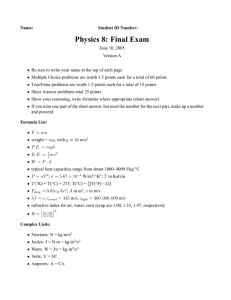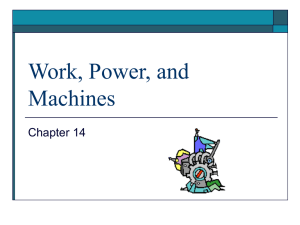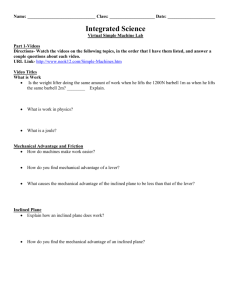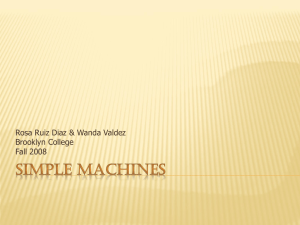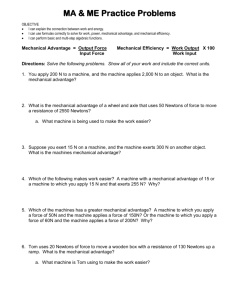Physical-Science
advertisement
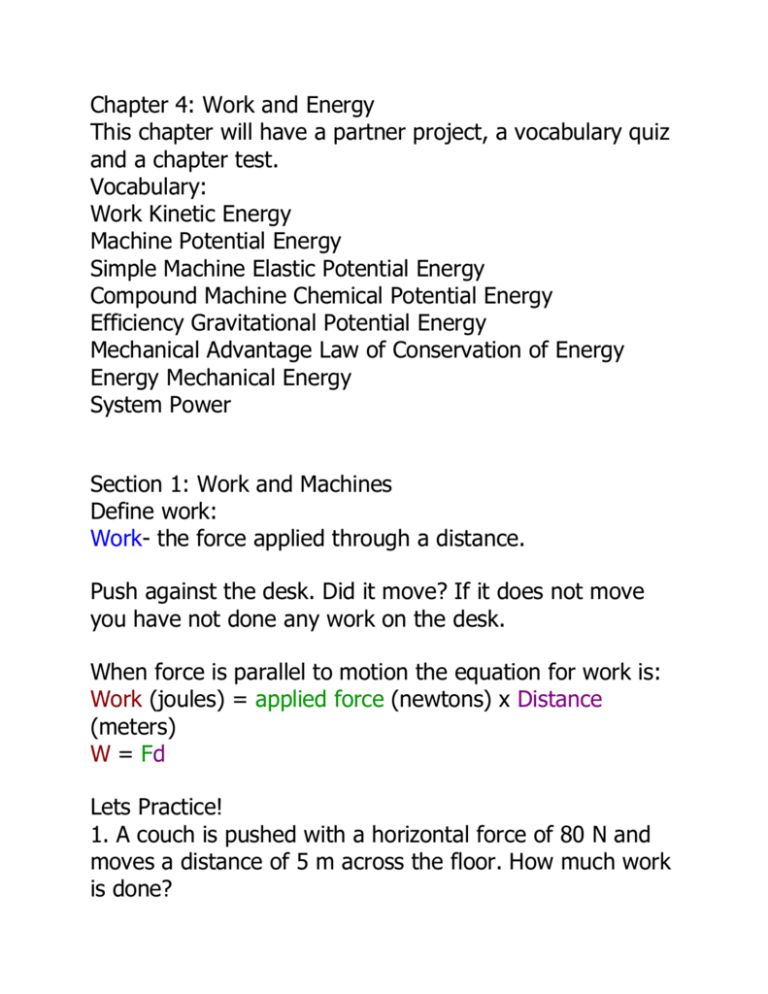
Chapter 4: Work and Energy This chapter will have a partner project, a vocabulary quiz and a chapter test. Vocabulary: Work Kinetic Energy Machine Potential Energy Simple Machine Elastic Potential Energy Compound Machine Chemical Potential Energy Efficiency Gravitational Potential Energy Mechanical Advantage Law of Conservation of Energy Energy Mechanical Energy System Power Section 1: Work and Machines Define work: Work- the force applied through a distance. Push against the desk. Did it move? If it does not move you have not done any work on the desk. When force is parallel to motion the equation for work is: Work (joules) = applied force (newtons) x Distance (meters) W = Fd Lets Practice! 1. A couch is pushed with a horizontal force of 80 N and moves a distance of 5 m across the floor. How much work is done? 2. How much work is done to lift a 100 N child 0.5 m? 3. The brakes on a car do 240,000 Joules of work in stopping a car. If the car travels 40 m while the breaks are being applied how large is the applied force that the brakes exert on the car? When a force is perpendicular to motion, the work from that force is zero. When you carry books while walking at a constant velocity, how much work are you doing? Why? Machines are devices that change the force or increase the motion from work. How could you move a piano? Machines can increase force, but can also increase speed as well. You go much faster on a bicycle than on foot. A bicycle is a machine! There are 6 Types of Machines you will use one or all of these in your projects! Simple Machines: A Simple Machine is a machine that does work with only one movement of the machine. 1. 2. 3. 4. 5. 6. Lever Wheel and Axle Pulley Inclined Plane Wedge Screw Modified Lever Modified Lever Modified Inclined Plane Modified Inclined Plane A Compound Machine is a combination of two or more simple machines: A Pair of Scissors--> 2 wedges and 2 levers Machines increase force or speed, but you cannot increase both at the same time, so you are not increasing the amount of work being done. In Fact! You always put more work into a machine than you get out of it. It does not matter how good your machine is, this law always holds true. The efficiency is the ratio of output work to input work. It is measured in percent using this equation: Output Work (joules) Efficiency (%) = x 100 Input Work (joules) WOUT e= x 100 WIN What is the efficiency of a machine that does 800 J of work if the input work is 2,000 J? The input work on a pulley system is 75 J. if the pulley system is 84% efficient, then what is the output work from the pulley system? Machines are useful in 3 major ways1-Increase speed a person on a bicycle travels more quickly than a person on foot, At the same time the force decreases. If you were to ride up a hill however, you force would increase and your time decrease. 2- Change the Direction of Force an ax takes an applied downward force and turns it into a force splitting a piece of wood apart-an outward force. 3- Increase Force if you use a machine to increase force you will decrease the speed. a car jack will help you exert a force to lift a car, however, you move the jack handle faster than the car lifts. We can describe the effectiveness of the machine at increasing force by its mechanical advantage. Mechanical Advantage is the ratio of the output force to the input force: Output Force (Newtons) Mechanical Advantage = Input Force (Newtons) FOUT MA = FIN What is the Mechanical advantage of a hammer if the input force is 125 N and the output force is 2,000N?





